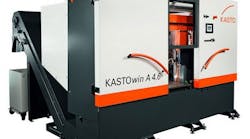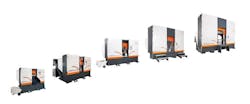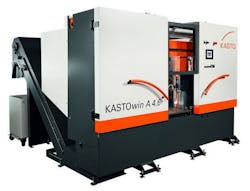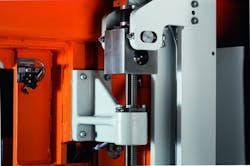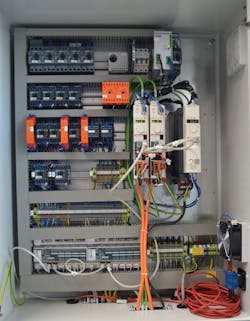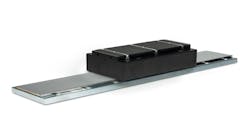Energy efficiency? Yes, but not at any cost. This is the goal of many metal-processing companies, which are tasked with balancing productivity and cost pressures. An example is sawing technology. KASTO Maschinenbau has paid particular attention to this when developing its new KASTOwin bandsaw series. This resulted in an extremely efficient band-sawing machine that allows the operator to make significant savings, without compromising on cutting performance (Figure 1).
Figure 1: When developing the KASTOwin series, KASTO paid particular attention to optimum energy efficiency.
(Source: KASTO)
Increasing cost pressure, tough international competition and ever-increasing customer demands mean metal-processing companies are facing significant challenges. On the one hand, it is important to be able to flexibly offer more and more different materials and sizes of the highest quality, from a batch size of one through series production. On the other hand, the unit costs must be low and competitive so that in-house production is economically viable. Finding a happy medium is a difficult task faced by many operators.
Sawing technology is also continuing to develop against this backdrop. As tasks become more complex, the requirements placed on machine manufacturers also increase. Automatic saws must meet diverse criteria, such as offering high-cutting performance, a wide range of applications, minimal idle times, perfect cutting results, high repeatability, ease of use and effective material use. In times of increasing energy costs and ever-longer daily periods of use, efficiency also plays a key role. The power consumption of a sawing machine used during a single shift can have a considerable influence on operating costs, and the costs are all the higher for two or more shifts.
But not every measure that improves a machine's energy efficiency is suitable for the user. These ideas often come at the expense of production capacity. However, KASTO, a metal sawing machine manufacturer, launched the KASTOwin. This machine has been developed for diverse areas of application and high cutting performance but also offers incomparably low energy consumption. In designing the new series, our aim was to develop a cost-efficient solution that does not compromise on function yet still meets all our customers' requirements and at the right price (Figure 2).
Figure 2: The aim was to develop a cost-efficient solution that does not compromise on function yet still meets all requirements and at the right price.
(Source: KASTO)
Pragmatic developments
One of Europe's oldest family-owned companies, KASTO celebrated its 170th anniversary in 2014. In the course of its successful history it has registered 160 patents, delivered more than 140,000 sawing machines to all parts of the world and installed more than 1,800 automatic storage facilities. It recently set out to make a more energy efficient sawing machine.
A thorough analysis of all the energy-consuming machine elements and their corresponding power requirements was the basis for the development work. Using the results, KASTO developed a series of concepts that would allow energy to be saved in different areas. We then evaluated these concepts from a commercial viewpoint; in other words, we weighed the increased cost of the investment against the possible operating savings. In doing so, we determined certain measures to be meaningful but others less so, and we then rejected the latter. However, a few points still needed to be addressed, significantly improving the energy efficiency of the new series.
The greatest potential lay in the hydraulics system, which is responsible for a major proportion of the sawing machine's energy consumption. Initially, it tested and compared equipment from different manufacturers and opted for the most efficient. To complement this, the KASTOwin engineers developed an electromechanical saw downfeed. The hydraulics system is now only used for workpiece clamping and saw-blade tensioning, so it is actuated far less than in the past. As a result, we were able to reduce the machine's overall energy consumption by around 30% (Figure 3).
Figure 3: Modern servo drives are used for the material infeed and saw downfeed. Linear guideways and ball screws ensure highly efficient, precise power transmission.
(Source: KASTO)
The required clamping force depends on the size of the individual machine. The KASTOwin range consists of five models, which cover a cutting range from 330 to 1,060 mm. The clamping force is applied with a maximum clamping pressure of 80 bar (1,160 psi) and the machine-dependent cylinder size.
The force for the saw downfeed is smaller than the gravitational force on the saw head. The maximum force required to drive the saw downfeed results from a high-speed upward movement at no-load.
Modern drive technology uses energy intelligently
For the saw motors, frequency-controlled drives of efficiency class IE3 from Schneider Electric are used. As a result, cutting speeds of 12 to 150 meters per minute can be achieved. At the same time, the servo motors are compact and extremely efficient. The servo motors' torque vary from 1.3 Nm to 6.8 Nm, dependent on the machine size.
Modern servo drives are also used for the material infeed and saw downfeed. Linear guides and ball-screw spindles ensure highly efficient, precise power transmission. Users therefore not only benefit from exact and repeatable sawing results, but also from low-energy requirements (Figure 4).
Figure 4 4: KASTO has fitted the frequency converter with a dc link: Excess energy can be recovered and used elsewhere in the system.
All drives are controlled by intelligent converter technology. The frequency converters are fitted with a dc link. Excess energy, which is generated when braking the saw motor, for example, can therefore be recovered and used elsewhere in the system. In contrast, conventional technology disperses this energy via brake resistance, so it is lost as heat. Our solution significantly lowers the saw's energy consumption.
KASTO engineers have also turned their attention to the weight of the sawing machines; after all, the more weight that needs to be moved for each cut, the more energy is required. Using new methods, dynamic parts such as the saw frame have been designed to be lighter without having to compromise on vibration damping or quiet operation.
Control adjustments
Our new system KASTOrespond, especially developed for this product series, KASTOwin and KASTOwin pro, offers a perfect machine adjustment for solid material, tubes and profiles of all types of material and is available for each size of machine. The system permanently records the forces on the tooling, without using additional and often fault-prone sensor systems and transforms the forces into the optimum digital feeding speed. KASTOrespond quickly recognizes thick-walled and thin-walled material, ever-changing contact lengths for tubes and even rough areas in solid material and transforms into the correct feeding speed. The operator only has to program the relevant data as cut-off length, number of pieces and material to saw. The rest is up to the sawing machine.
After having entered the requested cut-off length and number of pieces and after having activated the control function “zero positioning,” the first cut-off piece is positioned fully automatically at the requested cut-off length and then cut.
Various IPC controllers with differing function scopes are available. With the built-in HMI, users do not need any programming knowledge, they simply have to input the necessary job data, such as the cutting length and required quantity.
Rapid payback
Overall, these various improvements have made it possible to achieve significant improvements in the energy efficiency of KASTOwin bandsaws. Depending on the sawing task, energy consumption is on average almost 30% lower compared with similar previous models. Depending on operating times, operators can reduce their annual operating costs by several hundred dollars. Productivity is unaffected as we focus our development work on our customers' needs first and foremost.
The KASTOwin series offers high cutting performance and optimum results in different applications across various industry sectors, from machine and tool manufacture to the steel trade, automotive and aerospace engineering sectors.
And the saw also stands out from an economic point of view. Thanks to its excellent value for the money, the investment is often recouped in a very short time. The components are included in the standard version.
ALSO READ: Safe and fully integrated industrial chainsaws

Leaders relevant to this article:
